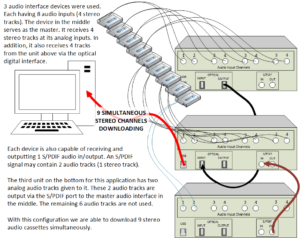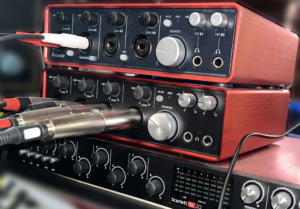At W. Cardone Productions our typical audio duplication to digital project comes to us from consumers. It might be a set of three or four audio cassettes of varied family events from yesteryear. Each cassette must be captured in real time. Let’s assume that each is a 90 minute cassette. The capture will therefore take 4×90 minutes which is about 6 hours. This can be accomplished in one day. But what if the client brought us one thousand 90 minute cassettes? That is 1,500 hours of “listening pleasure.” Assuming there are 8 hours per day for downloading, 1,000 cassettes would take well over 187 days to complete. Further, assume that due to limitations from having other projects to complete from other clients, only 25% studio time could be given to the project on such a long-term basis. We need to allow for one year to complete this very large project.
Under these conditions we would need to ask the client to submit “batches” of projects so, end-to-end, now a time to full project completion might be two or three years.
Earlier this year a client from a local radio station came to us with 30 years of audio broadcast archives to duplicate to digital. We at W. Cardone Productions don’t like to tell clients “no.” But at the same time, we are absolutely making sure that every client is satisfied under all conditions. Therefore, it was time to think out of the box. We told the client we could do the job in four months. The first two months were to gear up for the project and the second two months were to actually do the duplication to mp3. This was to be accomplished while still processing our usual complement of client legacy media.
It was time to think out of the box. Please refer to the image on the right.
 It is possible to duplicate audio cassettes very quickly by playing them at double or triple speed. This works for voice audio recordings where frequency equalization is not demanding. These audio cassettes, however, were music recordings. To play them in even just double time would dramatically reduce the quality of the duplication. Therefore there were no options to circumvent time limitations by speeding up the play speed.
It is possible to duplicate audio cassettes very quickly by playing them at double or triple speed. This works for voice audio recordings where frequency equalization is not demanding. These audio cassettes, however, were music recordings. To play them in even just double time would dramatically reduce the quality of the duplication. Therefore there were no options to circumvent time limitations by speeding up the play speed.
“Inside the box” thinking says there shall be one cassette downloading at any one time. But why not have nine (9) cassettes downloading simultaneously? But to do this, would you not need nine computers with nine professional audio cassette decks and audio interface devices? That is certainly one way to do it but not practical.
The solution we chose was to pretend that we were musical instrumentalists and use an audio interface. An audio interface accepts up to a specified number of audio inputs and puts them out via a USB cable to a computer while maintaining the discrete nature of each audio track.
We already had an audio interface capable of accepting up to 8 audio channels (4 stereo tracks) so initially, we were thinking that we could download in groups of 4 cassettes using 4 professional audio cassette decks into one computer. But when we worked out the math we found that this would not facilitate our target delivery date. It was time to continue thinking out of the box.
Our audio interface claimed the ability to handle up to 18 audio channels. The first 8 channels came into the device by regular audio lines in. But the device was capable of accepting another 8 audio channels via its optical input. The trick now was to figure out how to get another 8 channels into an optical cable to plug into our audio interface.
The solution was to buy another audio interface that had 8 audio channels in but also provided an optical line out that those 8 channels could be directed to. Plugging this unit into the original audio interface we could now accommodate up to 8 stereo tracks.
But wait a minute… Didn’t we say earlier that we were doing 9 stereo tracks? Yes, we certainly did.
Our original audio interface accepted 4 analog stereo tracks and 4 optical stereo tracks but ALSO accepted one S/PDIF stereo track. The solution: we bought a third audio interface accepting four stereo tracks but having the ability to output ONE of those stereo tracks into its S/PDIF output. This third audio interface’s S/PDIF output could then be plugged into the original audio interface’s S/PDIF’s INPUT such that we were then able to realize nine (9) stereo tracks downloading simultaneously.
 A photo of the actual setup is shown on the right.
A photo of the actual setup is shown on the right.
We now had the capability to feed 9 stereo tracks into the computer simultaneously. But what did that mean? It meant that now we needed 9 professional audio cassette decks to feed those 9 tracks plus an extensive array of BNC cabling to connect those stereo tracks.
The only viable solution for obtaining legacy media devices at affordable prices is eBay. In fact, this was the largest reason for specifying two months to “gear up.” While refurbished legacy equipment is available on eBay, its quality is unknown overall. What we at W. Cardone Productions do is buy legacy media devices at eBay that are being sold for parts and then refurbish them ourselves. By refurbishing them ourselves we know what the quality is and bring them up to factory specifications with regard to playing speed, line out voltage, replacing belts, and calibrating for RIAA frequency equalization.
What we do is, we pick one or two industry models that are known to be of professional quality and only buy those models becoming exceptionally technically familiar with those models. The model that we chose was the Nakamichi RX-202. The reason for this selection was that the RX-202 had the capability to automatically play in the reverse direction while STILL playing FORWARD! The problem with consumer “auto-reverse” decks is that in reverse mode they PLAY in reverse. This requires the play head to reverse as well. That creates alignment azimuth limitations. It is impossible to align a play head for two directions of play with the accuracy of one direction. Consequently, the professional decks don’t have an auto-reverse capability…EXCEPT for the Nakamichi RX-202. The RX-202 has a jute box mechanism that physically flips the tape around and then plays it in the forward direction.
There were disappointments along the way purchasing units that we could not use but this is to be expected.
There is considerably more we could report on concerning this project since capturing the raw mp3s was just one part of the job. Everything had to be digitally processed for consistency, sorted, and ultimately delivered to the client for delivery to the United States Library of Congress. Capturing the media was probably about 65% of the job.
